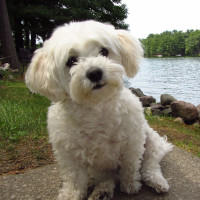Appearance of the Maltichon
|
| The Maltichon is a tiny but well-built dog with soft white fur that can be silky or velvety. They have small, slightly rounded heads with medium-length square muzzles that can be tapered if the cross takes more after the Maltese than the Bichon frise. This hybrid has dark, round eyes that have black lids that amplify their gentle yet alert expressions, as well as floppy ears that are set moderately high on the head and can be covered with copious amounts of hair. Although the color of the parent breed is generally a fairly uniform white, the Maltichon can sometimes have apricot, buff and cream markings, and coat length and texture can vary considerably from dog to dog, even within the same family. same litter. The coat of the Maltese is a long, straight, single-layered coat that can become quite long, and the Bichon frise has a double-layered coat made up of a short, dense undercoat covered by a layer of medium-length wavy or curly hair that has a texture more akin to plush or velvet. Crosses can inherit qualities from either of the parent breeds. |
Temperament of the Maltichon
|
| Both parent breeds were bred for companionship and are generally bright, lively and inquisitive canines, just like the Maltichon. In most cases, they are outgoing and engage with all ages as well as other animals, although interactions between this small dog and young or boisterous children or larger animals must be closely supervised to avoid rough, clumsy or inattentive behavior that could result in hurt feelings or even injury on the part of the child or dog. They are fairly easy to train, although short, stimulating training sessions are most effective, and they can have a stubborn streak, especially when trained at home. Early training and socialization are particularly important in preventing the formation of traits such as shyness, insecurity and yapping in toy-sized dogs like the Maltichon. They are a very people-oriented hybrid and may be slightly more prone to developing separation anxiety than most breeds. |
Needs and activities of the Maltichon
|
| Although this dog is a lively animal, its small size means it can generally expend quite a lot of energy without you having to exert much effort. While Maltichons will certainly enjoy short walks around the block, they will appreciate frequent breaks, every twenty minutes or so. Hybrids that inherit the Maltese's characteristic single-ply coat may be a little more sensitive to the cold than other dogs, and if you live in a colder climate, sweaters and jackets designed for your canine companion may be a good investment. These dogs are also highly intelligent, and boredom can lead to anxiety, destructive behavior and excessive barking. Puzzles and toys designed for dogs and games of hide-and-seek are appropriate methods of preventing mischief by keeping their quick little minds occupied. |
Maintenance of the Maltichon
|
| This dog requires more effort than most when it comes to grooming. Both parent breeds need fairly frequent baths, every three to four weeks, and this is also true for the Maltichon dog. Conditioner formulated for dogs should also be applied to the coat after bathing to help keep this dog's hair healthy and supple, and brushing and combing should take place daily to remove tangles and prevent matting. Both the Bichon frise and the Maltese are low-loss dogs that have been classified as hypoallergenic, and Maltichons dogs share this classification. |









 English (United Kingdom)
English (United Kingdom)